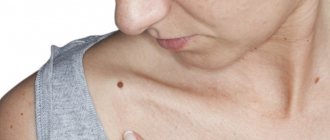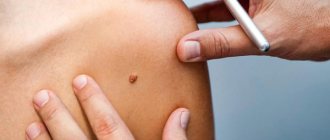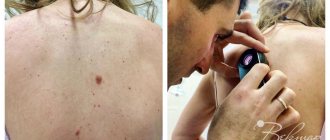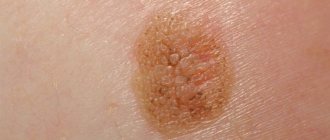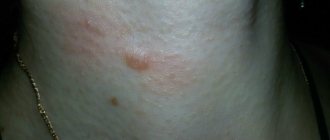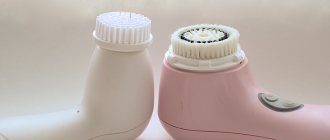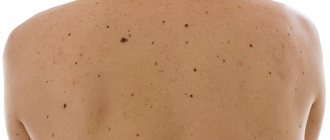Home > Laser surgery / Removal of tumors / Removal of moles > Laser removal of moles on the face
Moles, as a rule, do not pose a serious danger to humans, but over time, some of them can degenerate into a malignant tumor.
It is not necessary to remove moles: they are a harmless formation that occurs in everyone without exception. However, some of them become an aesthetic problem, for example, if they are on the face. Removal may also be recommended by a doctor.
Consultation on the day of the procedure is free
Mole - dangerous or not?
A mole is a neoplasm consisting of melanocytes. It can be black, brown, red, even gray. Moles, unlike birthmarks, appear with age: the older a person is, the more formations there are on his skin. Many of them are safe, do not require removal and do not cause discomfort to the “carrier”.
When should you remove a mole?
It is believed that a mole should remain on the body or face, and removing it is simply dangerous. It is a myth. Yes, in some cases, after removal, a person may be sent to the oncology department. However, we are talking about advanced cases of a malignant tumor.
Some of the moles degenerate into malignant neoplasms. Over time, cancer “takes root” in the human body, and such a tumor cannot always be completely removed: metastases reach the most important organs.
Important : if a mole begins to grow or acquires a different color or shape, you need to consult a doctor. It's better to do this immediately. The oncologist will take the tissue for analysis and determine how dangerous the mole is. If cancer cells appear, the tumor must be promptly removed.
Of course, not every mole is reborn. Sometimes removal is necessary for aesthetic purposes. Most often, patients at cosmetology clinics are concerned about a growth on their face. Even a small nevus can “ruin” your face.
Safe moles
A “calm” mole has a number of distinctive features:
• Its diameter does not exceed 0.5 cm;
• The general structure corresponds to the microrelief of nearby skin;
• Hair growth is observed on the neoplasm;
• Has clearly defined boundaries;
• Grows slowly and steadily, almost imperceptibly for the owner;
• It has the shape of a spot or a plaque slightly raised above the surface of the skin.
A safe nevus can change shape and color over time, and this is not something to be afraid of. However, it is recommended to remove raised moles in any case, especially if they are located in potentially traumatic places. Tearing off a raised mole and eliminating it on your own with the help of threads and other improvised means can lead to oncology.
It's worth removing a mole:
1. Located on the neck or décolleté (due to constant irritation from jewelry, scarves and closed clothing);
2. Localized in the armpit or pubic area (due to the risk of injury from the razor);
3. Rapidly growing and changing shape;
4. Causing pain, itching and burning when rubbed with fabric;
5. Bringing purely aesthetic discomfort.
Cost of laser mole removal
| Laser tumor removal | Prices, rub. |
| Laser removal of papillomas, single warts - Cat. I. difficulties | 1200 |
| Laser removal of papillomas, multiple warts - Cat. I. difficulties | 350 |
| Laser removal of moles, papillomas, warts - Cat. II. difficulties | 700 |
| Laser removal of moles, papillomas, warts - Cat. III. difficulties | 1500 |
| Laser removal of moles, papillomas, warts - IV category. difficulties | 3000 |
| Laser removal of moles, papillomas, warts - Cat. V. difficulties | 4500 |
| Laser removal of moles, papillomas, warts - Cat. VI. difficulties | 6100 |
| CO2 Laser callus removal (per unit) | 6100 |
| Removal of atheroma, lipoma, fibroma, xanthelasma with laser - Cat. I. difficulties | 6 900 |
| Removal of atheroma, basal cell carcinoma, lipoma, fibroma, xanthelasma with laser - Category II. difficulties | 9 400 |
| Removal of atheroma, basal cell carcinoma, lipoma, fibroma, xanthelasma with laser - Cat. III. difficulties | 16 900 |
| Removal of atheroma, basal cell carcinoma, lipoma, fibroma, xanthelasma with laser - IV category. difficulties | 22 400 |
| Removal of atheroma, basal cell carcinoma, lipoma, fibroma, xanthelasma with laser - Cat. V. difficulties | 33 400 |
Make an appointment for laser removal of moles on the face
- Full name
- Telephone
How are moles removed?
There are different methods for removing moles. Small ones are removed using a laser or radio wave apparatus, large ones are cut out or burned out. There are a lot of technologies. The most common and popular are:
- Surgical method. Removal in the traditional way - using a scalpel - is a painful and dangerous procedure. During the operation, it is easy to introduce an infection into the blood, which leaves a scar (and scars do not paint faces), which is extremely difficult to remove. The patient himself has to take antibiotics to prevent possible blood poisoning.
- Radio wave method. One of the good ways to remove small tumors. Suitable for the face too. Relatively safe, but not always quite effective.
- Laser method. The laser simply burns out the tumor. A small burn remains where the mole was. It heals relatively quickly. Adjacent tissues remain intact. The laser is also suitable for the face.
The choice in favor of one method or another can be made based on the size of the mole, budget and, above all, the doctor’s recommendations. In general, all methods are suitable for removing tumors, but small nevi are best removed without a surgical scalpel.
Why is it worth using the laser removal method?
Laser technologies are universal. They help remove not only a mole, but also any other growth on the body or face, regardless of where it is located. When removing a nevus, a narrowly directed high-power laser beam is used, which does not affect adjacent tissues of the face or body. With its help, you can remove both a small nevus and a large tumor. There will be practically no marks left on your face. A small laser burn will heal quickly.
Photos before and after the procedure
Why remove tumors
Moles and papillomas can pose a real threat to human health and even life. For example, a nevus can degenerate into one of the most aggressive types of cancer - melanoma. Usually the tumor progresses rapidly, since the body’s response is weak or absent altogether. Strong immunity can suppress the development of the papilloma virus. Often, the growths that appear disappear on their own without a trace. If the immune response is insufficient, the tumor will not disappear. It may even increase in size. In place of one papilloma, several appear at once. The growths can become injured and become infected. In addition, papilloma can cause the development of squamous cell carcinoma and other types of cancer. Removal of moles and papillomas can be carried out only after consultation with a doctor.
If there is a suspicion of malignant degeneration of the nevus, it must be eliminated with extreme caution and only in a medical facility. After the procedure, tissues are necessarily sent for histological examination. The same is done with suspicious papilloma. In this case, the optimal way to remove the tumor is surgery. Fortunately, not all nevi and papillomas are dangerous. They rarely develop into melanoma or other types of cancer. Most often, patients remove moles and papillomas for aesthetic reasons.
Our specialists
- Kiani Ali
Candidate of Medical Sciences, laser medicine specialist, dermatocosmetologist.
Sign up
- Stepanova Inna Igorevna
Candidate of Medical Sciences, maxillofacial surgeon, specialist in laser medicine.
Sign up
- Fedotova Marina Andreevna
Surgeon, dermatocosmetologist, laser medicine specialist
Sign up
- Popovkin Pavel Sergeevich
Surgeon, oncologist, laser medicine specialist.
Sign up
Advantages of laser “surgery”:
- Safety. There is no risk of blood poisoning - there will simply be no blood in the place where the “operation” is performed.
- No large scars. Small burns will not last long after you remove small nevi. This is especially important in the case of the face, where it is extremely important to avoid any marks.
- Versatility. Using a laser, you can destroy both large and tiny nevus. It doesn’t matter what size and shape the mole has - with a laser device, the cosmetologist will remove even a flat pigment spot.
- Low price and short term. Removing a nevus does not require special preparation. As a rule, in Moscow the “operation” is carried out immediately after the application - at a very affordable price.
Radio wave removal
Radioknife is another effective means for removing moles and papillomas. But it can only be used if the doctor is sure that malignancy of these tumors has not occurred. In addition, the radioknife is contraindicated for pregnant women and people who have a heart rate sensor in their body. High-frequency waves evaporate nevus or papilloma cells. Healthy tissues are not harmed. The operation is painless and lasts no longer than 25 minutes. There is no bleeding, so there is no need for postoperative wound care.
Hypertrophic scar - mechanism and causes.
What is a scar? Any damage to the skin - a scratch or post-operative suture - always ends in tissue restoration. Under certain conditions, which are currently not fully known, the regeneration process is disrupted. Instead of normal cells, the body forms an excess number of fibroblasts at the site of injury. Our blood vessels, ligaments and tendons are made up of them and their descendants. The appearance of these cells in large quantities at the site of skin damage is expressed in the appearance of scars.
There are several known factors among the causes of scars:
- Large depth and area of skin damage
- Deficiency of ascorbic acid, oligoelements (silicon, cobalt, iron, copper, potassium, magnesium, calcium, zinc, selenium), oxygen
- Dysfunction of the endocrine system (thyroid, adrenal glands)
- Decreased general and local immunity
- Dysfunction of the regulatory functions of the central nervous system
Basic recommendations after removal of nevi
Regardless of the reason that prompted the patient to remove a raised mole, some restrictions should then be followed. These include avoiding contact with water for a week, avoiding sunbathing for several weeks, and using sunscreen in the future. The latter is relevant for all people who have many large convex nevi on the body. If for small tumors tanning for 10-15 minutes is acceptable, then for large moles even it can provoke the formation of cancer. If you stay on the beaches under an umbrella and don’t forget about ultraviolet protection, you don’t have to worry about skin cancer.
Attention!
This article is posted for informational purposes only and under no circumstances constitutes scientific material or medical advice and should not serve as a substitute for an in-person consultation with a professional physician.
For diagnostics, diagnosis and treatment, contact qualified doctors! Number of reads: 3248 Date of publication: 09/11/2018
Dermatologists - search service and appointment with dermatologists in Moscow
Prevention of scarring.
So, you're about to remove a mole and don't want a scar to form afterwards. Some of the recommendations are not easy to implement. However, I think that once you can strain for a good cosmetic result - after all, you have to live with it for the rest of your life.
Before deleting:
- Buy a good multivitamin and take the course for 15 days. Vitamins A, B, E, C are especially important.
- Take dietary supplements and eat foods that contain silicon, cobalt, iron, copper, potassium, magnesium, calcium, zinc, selenium.
- Drugs to improve microcirculation - theonicol, capillary.
- Drugs that strengthen the vascular wall: ascorutin, etamzilate.
- Over the same 15 days, try to increase your sleep volume to 7-8 hours a day.
- Physical activity and massage are also encouraged. They will also help improve microcirculation.
- To remove moles up to 1 cm, choose the method that least damages the skin - laser or radio knife.
- Choose an experienced doctor
After removal:
- Continue taking all medications and supplements listed above.
- To treat the wound, use hyaluronic acid preparations, which help create a moist environment in it. This should be done until the crust falls off.
- After the crust falls off, use silicone-based gels or plates. They are, according to the British Association of Plastic and Reconstructive Surgeons, most effective in preventing scarring.
- Avoid direct sunlight on the removal site for 2 months. Sunscreen with a protection factor (SPF) of 50 successfully solves this problem.
Preparing for the intervention
No preparation is required for surgery: you can eat and drink water without restrictions, and you do not need to take medications. However, it is important for women to plan the day of surgery taking into account the menstrual cycle; it is better to do this after menstruation. The recommendation applies to any surgical intervention. Also, in cases where the nevus is located on open areas of the body, it is better to remove it from October to April. This will eliminate the need to hide the wound and protect it from ultraviolet rays.
If you are taking medications that affect blood clotting, tell your surgeon. You should not stop taking medications on your own—check with your doctor.

